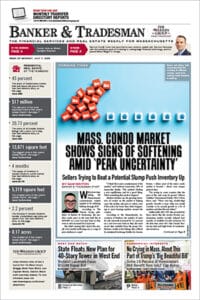
Christopher Kuschel
Take a drive through any community in Metro Boston and you’re bound to pass by at least a few retail properties that are past their prime, if not downright shabby. Mid-century strip malls, aging retail plazas and worn-out mini-malls: they’ve all faced bruising competition from e-commerce, new lifestyle centers and revitalized downtown districts.
As a result, vacancies are up, rents are down, and tax revenues have fallen at many formerly thriving retail properties. Left unchecked, these trends could have bad outcomes for owners, municipal officials and neighbors. Even when retail spaces are performing well, there are often opportunities for revitalization by adding homes while also maintaining commercial usage.
Fortunately, many of these retail sites could hold the key to solving some of the region’s most challenging problems: housing affordability, congestion reduction, environmental protection and racial disparities.

Tim Reardon
Across the country and right here in Greater Boston, communities have seen residential and mixed-use development of old commercial sites into thriving neighborhoods and centers, generating widespread benefits along the way. In Woburn, for example, an old mini-mall has been reborn as “Woburn Village,” with apartments, open spaces and shops that provide needed homes, amenities and tax revenues for the community.
Excited by the possibilities of such redevelopment, the Metropolitan Area Planning Council conducted a regional analysis of retail sites. Our new report, “Rethinking the Retail Strip”, quantifies the opportunity, prioritizes the best sites and identifies policy measures needed to overcome barriers to creative reuse.
Huge, Transit-Oriented Potential
The potential is huge: MAPC’s analysis shows that the Greater Boston region has more than 3,000 sites – covering more than 13.7 square miles – of strip malls and similar commercial properties. Many of these sites are well-suited to mixed-use development. After identifying the sites, we prioritized them based on multiple indicators, including proximity to transit, Walkscore, potential buildout, environmental issues, measures of underutilization and more.
If the top 10 percent of sites in each municipality were retrofitted with new mixed-use development – an average of fewer than four sites per community – it could create 125,000 housing units while adding or maintaining thousands of square feet of commercial or flex space, generating an estimated $481 million increase in net tax revenue for the host municipalities.
The benefits extend well beyond housing production. Retail retrofits can enable communities to accommodate new growth without the loss of the valuable open space required for new subdivisions or greenfield multifamily development. By “de-paving” massive parking lots and replacing them with green infrastructure and clean energy, retrofits can reduce flooding, cool the air and reduce electrical demand.
We also found that nearly one-third of the sites are within a half-mile of transit. If designed well and connected to surrounding neighborhoods or regional transit, redevelopment may provide new residents with the opportunity to meet some of their daily needs for commuting and shopping without having to get in a car. In that way, it can also reduce car usage, traffic congestion and auto-related greenhouse gas emissions.
Attention to Detail Vital
However, getting these retrofits right will require careful attention to detail and development practices that remain uncommon in Massachusetts.
Planning for these areas should be done holistically, not as a single site, but rather on the neighborhood level, taking into account housing goals, transportation needs, market demand and other factors. Equity should be prioritized, with minimum requirements for affordable housing and housing appropriate for families. Equity also means that existing commercial tenants –especially small businesses – are involved in the planning and have an opportunity to stay.
Finally, site design and transportation infrastructure should prioritize people, not cars. This means focusing on safe and pleasant pedestrian travel, human-scale design approaches and a bare minimum of parking.
Towns, State Hold Keys to Success
Even with thoughtful site identification, planning and design, municipalities and developers often face barriers that hinder creative redevelopment. Often, the biggest barrier is one that the municipality controls: zoning.
By updating local bylaws or ordinances to allow residential and mixed-use development on these sites, communities can be proactive about guiding change. Done well, new zoning can also generate Smart Growth Zoning incentive payments from the state, ensure additional school costs are reimbursed by the state and help satisfy the requirements of the MBTA Communities multifamily zoning requirement.
Since water and wastewater infrastructure is often a blocker to new growth, state investments and regulatory adjustments will also be needed to unlock development potential on these sites. And landowners unfamiliar with new-fangled development models need outreach and education to guide and reassure them as they take advantage of these emerging opportunities.
Change can’t happen overnight. It took decades of sprawling, auto-oriented development to get us where we are today. Re-envisioning and remaking the retail strip provides one opportunity to correct those problems in a sustainable and equitable manner. But by working together, over the course of the next decade, thoughtful reuse of these sites could benefit the entire region, helping us achieve our housing, transportation, and environmental goals.
If we get it right, once-shabby retail strips may become both a powerful symbol of the suburbs’ past, and the key to their bright future.
Christopher Kuschel is principal planner and Timothy Reardon is data services director at the Metropolitan Area Planning Council.




